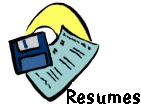
- Los Angeles
- Sacramento
- San Diego
- San Francisco
About JobStar
Privacy Policy
Contents
 |
|
 Resume Tips from Yana ParkerVisit Yana's Damn Good Resume Site for more! |
5 Key Concepts for Powerful, Effective Resumes
- Your resume is YOUR marketing tool, not a personnel document.
- It is about YOU the job hunter, not just about the jobs you've held.
- It focuses on your future, not your past.
- It emphasizes your accomplishments, not your past job duties or job descriptions.
- It documents skills you enjoy using, not skills you used just because you had to.

10 Steps in Creating a Damn Good Resume
- Choose a target job (also called a "job objective"). An actual job title works best.
- Find out what skills, knowledge, and experience are needed to do that target job.
- Make a list of your 2, 3, or 4 strongest skills or abilities or knowledge that make you a good candidate for the target job.
- For each key skill, think of several accomplishments from your past work history that illustrate that skill.
- Describe each accomplishment in a simple, powerful, action statement that emphasizes the results that benefited your employer.
- Make a list of the primary jobs you've held, in chronological order. Include any unpaid work that fills a gap or that shows you have the skills for the job.
- Make a list of your training and education that's related to the new job you want.
- Choose a resume format that fits your situation--either chronological or functional. [Functional works best if you're changing fields; chronological works well if you're moving up in the same field.]
- Arrange your action statements according to the format you choose.
- Summarize your key points at the top of your resume.
Yana says: In REAL-LIFE resume writing, we DO skip around.
So don't worry if YOUR resume comes together in some other sequence--as long as you do #1 and #2 first!